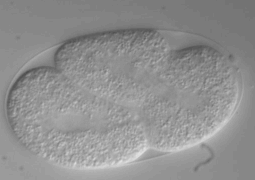Introduction
Transposable Elements are expressed in the C. elegans early embryo and involved in his development, but they might also have an impact on pathologies and neurodegenerative diseases.
Transposable Elements (TE) are mobile sequences present throughout the genome. Their involvement in physiological and pathological processes needs to be clarified but appears to be related. This work of Federico Ansaloni et al. is about the expression and regulation of TE during different stages of embryogenesis.
They highlight TE transcription regulation in this model, even if its low, different TE are expressed in different cell types and stages, suggesting functions during early embryo development.
Ultra fast temperature shift device for in vitro experiments under microscopy
Abstract
“Transposable Elements (TE) are mobile sequences that make up large portions of eukaryote genomes. The functions they play within the complex cellular architecture are still not clearly understood, but it is becoming evident that TE have a role in several physiological and pathological processes. In particular, it has been shown that TE transcription is necessary for the correct development of mice embryos and that their expression is able to finely modulate transcription of coding and non-coding genes. Moreover, their activity in the central nervous system (CNS) and other tissues has been correlated with the creation of somatic mosaicisms and with pathologies such as neurodevelopmental and neurodegenerative diseases as well as cancers.”
References
FAQ
Transposable Elements, often called TEs, are defined as mobile sequences. These sequences are present throughout the genomes of eukaryotes. TEs actually make up large portions of these genomes. The complete functions that TEs perform within the complex architecture of a cell are still not clearly understood by researchers. Despite this, it is becoming more evident that these elements have a part in several physiological processes. They also appear to be part of pathological processes. The specific involvement of TEs in both healthy and diseased states is an area that requires further clarification, but a relationship is apparent.
The transcription of Transposable Elements (TEs) is known to be a requirement for correct development in certain animal models. For example, TE transcription is necessary for the proper development of mice embryos. The expression of TEs is also understood to be able to regulate the transcription of other genes. This effect applies to both coding and non-coding genes. In C. elegans, the expression and regulation of TEs during different stages of embryogenesis were studied. This work showed that TE transcription is regulated in this model organism. While the level of transcription is low, different TEs are expressed. This expression occurs in different cell types and at different stages, which suggests TEs have functions during the early development of the embryo.
Transposable Elements (TEs) are believed to be part of certain pathological processes. Evidence is becoming clear that they have a role in these conditions. Specifically, the activity of TEs within the central nervous system (CNS) and in other tissues has been examined. This activity has been correlated with the creation of somatic mosaicisms. TE activity has also been associated with several types of diseases. These include neurodevelopmental and neurodegenerative conditions. An association with cancers has also been noted. In C. elegans, it is similarly suggested that TEs might have an effect on pathologies, including neurodegenerative diseases. Clarifying this involvement is a goal of current research.
This work by Federico Ansaloni et al. concerned the expression and regulation of Transposable Elements (TEs). The study was performed during different stages of embryogenesis in C. elegans. The research showed that TE transcription is regulated in this particular model organism. Although the level of this transcription was found to be low, it was not absent. It was observed that different TEs are expressed in different cell types. This expression also varies across different developmental stages. These findings are important. They suggest that TEs have functions that are part of the early development of the embryo. The study helps to clarify the involvement of these mobile sequences in physiological processes.




